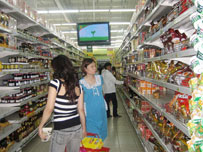
| Manufacturers shun supermarkets in favor of shops, markets | |
Some manufacturers are finding it cheaper and less hassle to sell their goods through markets and street-front shops rather than supermarkets and shopping-center stores. One such company is Da Gia, which makes the clothing brand Youth Fashion. Its director, Dao Van Dung, said the procedures for distributing goods through supermarkets consumed too much time and energy. For example, suppliers must wait for the supermarkets to accept their wares, and wait again for them to request delivery to the stores. That’s why Da Gia opts for market stalls and streetfront boutiques, where these problems don’t crop up. “It’s going well,” said Dung, and singled out Ho Chi Minh City’s Ben Thanh Market for special mention. Another bonus is that the bills are settled promptly, unlike with the supermarkets.
What’s more, the shopkeepers and stall vendors report their customers’ feedback on product quality and design faster than the supermarkets.
The Asia Shoe Company observed that suppliers typically bear the full brunt of the cost when their goods are damaged by supermarket shoppers, whereas market vendors are more likely to share it.
A cosmetics company director, who wished to be identified only by her first name Nguyen, said supermarkets often demanded an upfront payment of VND5 million (USD282) for each product a supplier wanted to put on the store shelves, so the cost to the supplier could be prohibitive. “But if any product fails to meet the sales target, it will be taken off the shelves. And it costs another VND5 million to introduce a product again,” Nguyen added.
While soft drink maker Tan Hiep Phat has gained a foothold in the supermarkets with its Number 1 energy drink, Tra Xanh Khong Do sweetened green tea and Dr. Thanh sweetened herbal tea, supermarket sales account for only 2.5 percent of its total revenue, the company said.
Other popular brand manufacturers like cosmetics maker My Hao and cookware manufacturer Kim Hang also rely very little on the supermarkets, which account for 3-5 percent of their sales.
Nguyen Thi Hai, director of the Hanoi Supermarket chain, said the big movers at supermarkets were consumer staples like sugar, milk and monosodium glutamate. Shoppers were not there for “high-end” clothes, she said.
Supermarkets estimate that 70 percent or so of their customers earn between VND1.5 million and VND5 million a month.
Hai said suppliers of expensive brandname clothing should not distribute their products through supermarkets as slow sales would soon make their displayed goods look old and out-of-fashion, and thereby affect their brand image.
Referring to processed food, Hai said shoppers already had their favorites so it was hard for newcomers to make their presence felt as the public was very cautious about trying something unfamiliar.
Vietnam, which has a population of around 86 million, has an estimated 250 supermarkets and shopping centers, and 1,000 convenience stores, according to the Ministry of Industry and Trade. These numbers are modest compared with the 9,000 markets and 250,000 street-front shops in the ministry’s figures. | |
| SGTT |
